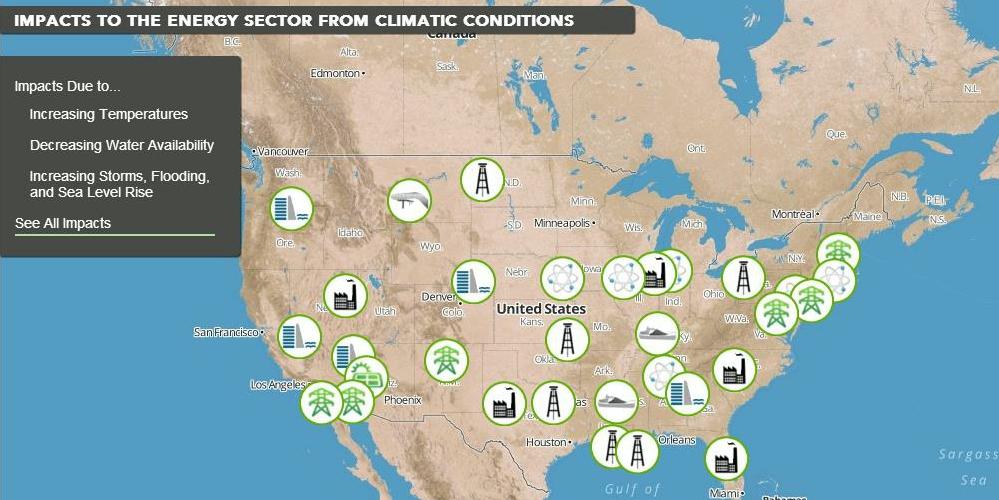 Impacts to the US energy sector from climate conditions. (Source: U.S. Department of Energy) A detailed legend can be found on http://energy.gov/articles/climate-change-effects-our-energy.
Impacts to the US energy sector from climate conditions. (Source: U.S. Department of Energy) A detailed legend can be found on http://energy.gov/articles/climate-change-effects-our-energy.Since the start of the 20th century, average annual temperatures across the contiguous United States have increased approximately 1.5°F (0.8°C). In recent years historically high temperatures have been accompanied by droughts and extreme heat waves, more wildfires than usual, and several intense storms that caused power and fuel disruptions. These trends, which are expected to continue, could restrict the supply of secure, sustainable, and affordable energy, according to the new report by the U.S. Department of Energy.
The implications for America’s energy infrastructure include:
- Increased risk of temporary partial or full shutdowns at thermoelectric (coal, natural gas, and nuclear) power plants because of decreased water availability for cooling and higher ambient and air water temperatures. Thermoelectric power plants require water cooling in order to operate. A study of coal plants, for example, found that roughly 60 percent of the current fleet is located in areas of water stress. (There are, however, some technologies underway that could make it possible to cool thermal power plants using no water at all).
- Reduced power generation from hydroelectric power plants in some regions and seasons due to drought and declining snowpack. For example, earlier spring snowmelts could decrease summer water availability leading to potential hydropower shortages when energy demand for cooling is greatest.
- Risks to energy infrastructure located along the coast from sea level rise, increasing intensity of storms, and higher storm surge and flooding — potentially disrupting oil and gas production, refining, and distribution, as well as electricity generation and distribution.
- Increasing risks of physical damage to power lines, transformers and electricity distribution systems from hurricanes, storms and wildfires that are growing more intense and more frequent.
- Increased risks of disruption and delay to fuel transport by rail and barge during more frequent periods of drought and flooding that affect water levels in rivers and ports.
- Higher air conditioning costs and risks of blackouts and brownouts in some regions if the capacity of existing power plants does not keep pace with the growth in peak electricity demand due to increasing temperatures and heat waves. An Argonne National Laboratory study found that higher peak electricity demand as a result of climate change related temperature increases will require an additional 34 GW of new power generation capacity in the western United States alone by 2050, costing consumers $45 billion. This is roughly equivalent to more than 100 new power plants, and doesn’t include new power plants that will be needed to accommodate growth in population or other factors.
Some of these effects, such as higher temperatures of ambient water used for cooling, are projected to occur in all regions. Other effects may vary more by region, and the vulnerabilities faced by various stakeholders may differ significantly depending on their specific exposure to the condition or event. However, regional variation does not imply regional isolation as energy systems have become increasingly interconnected. Compounding factors may create additional challenges. For example, combinations of persistent drought, extreme heat events, and wildfire may create short-term peaks in demand and diminish system flexibility and supply, which could limit the ability to respond to that demand.
In addition to identifying critical areas at risk from climate change and extreme weather, the report also identifies activities already underway to address these challenges, and discusses potential opportunities to make the energy sector more resilient. Potential future opportunities for federal, state, and local governments could include innovative policies that broaden the suite of available climate-resilient energy technologies and encourage their deployment, improved data collection and models to better inform researchers and lawmakers of energy sector vulnerabilities and response opportunities, and enhanced stakeholder engagement. These activities will increase the resilience of our energy infrastructure by “hardening” existing facilities and structures to better withstand severe droughts, floods, storms or wildfires and by contributing to smarter development of new facilities.

